John Hurrell – 21 October, 2010
Yet there is a problem with such decency. Well, not with being kindly disposed, but with an embracing of cliché. Some works are too corny in their espousal of ‘the human condition' - whatever that might be. They seem overstated and crass.
Ron Mueck has had a conspicuous international profile for his ‘hyper-realistic’ sculptures for almost fifteen years now. His thirteen works now being shown in Christchurch have been having extraordinary national publicity. They are an excellent introduction to a sculptural practice that explores corporeal detail and the psychology of varied scale.
Here we can look (and learn to look) closely at the human body without being distracted by any moving parts, overpowering odours, booming or shrill voices, fear of being crushed or our doing the squashing. We can play God and look down on the diminutive examples of these ‘folk’ from a height, or we can ignore the plinths and white tape that isolates them and imagine the large ones looking down on and wondering about us. Mostly they seem to be occupied with mental and physical concerns far beyond our presence.
In their particular tradition these sculptures are halfway between Duane Hanson’s lifesized dressed figures of the seventies and Patricia Piccinini’s sci-fi mutants of the nineties - or Robert Gober’s truncated body parts - but more playful with scale. Similar to the literature of Jonathan Swift in Swift’s verbal descriptions, but with no satire or malice, Mueck seems to like his fellow humans and always treats his subjects with dignity and affection.
Yet there is a problem with such decency. Well, not with being kindly disposed, but with an embracing of cliché. Some works are too corny in their espousal of ‘the human condition’ - whatever that might be. They seem somewhat overstated.
For example Man in Boat is about life as an existential voyage, and while the anxious naked fellow crouching in the wooden bow is superb in his quizzical peering, the battered craft itself is an overused trope. Likewise is Mask II, a sleeping male face that is fantastic in its lugubrious expression and coarse stubble but which is in fact hollow like a cardboard visage, with flat ears for flaps. It is a symbol for a front facial veneer suggesting social pretence. Perhaps the sleeper is really awake
Other works are particularly trite. Two Women features two whispering city dwellers, little elderly ladies that ooze furtive malice and snide banter. A giant seated Wild Man seems to explore mental disintegration and desperate panic, linking such states to nakedness, long hair, darting eyes and unruly beard.
Yet there are wonderful works here too that radiate common sense and contemplative nuances. As a sixty year old man who has successfully avoided fatherhood all my life, I found the large standing pregnant woman educationally fascinating. It got me wondering about the dynamics of the fecund maternal body in a way I’d never considered before. And in another room a huge recently born baby girl - with a wrinkled face, one ‘malevolent’ dark squinty eye, blotchy skin covered with bloody smears, and glistening purple umbilical cord - is also compellingly informative.
One sculpture here that brought Mueck considerable renown in the famous 1997 Royal Academy Sensation show in London is Dead Dad, a two-thirds-sized image of his own father’s body. The pink skin is just starting to turn greyish and the corpse seems to be smaller than what it is. It seems more like half scale, and the finality of death is accentuated by the splayed feet and upward turned palms.
My favourite work though is another small sculpture, Drift, with a Jack Nicholsonlike man in baggy blue shorts, gold chain and sunnies lying on a translucent green lilo hovering vertically out from the wall. His relaxed tanned arms (with silver watch) are stretched out in a vaguely crucifixion pose, something that is delightfully sacrilegious in its touristic decadence.
Apart from the impudent humour the lighting of this work is amazing. Mueck has done it so that the lilo’s shadows on the wall create rippled layers of darkening tones at the edges - like scalloped green Michael Harrison washes. The wall is just as beautiful as the object held out away from it.
This exhibition is an excellent introduction to Mueck’s technically amazing practice, but it reveals many of his weaknesses too - especially his occasional taste for mannered facial expression and theatrical, exaggerated body poses. These are perhaps the inevitable consequences of his consistent attempts to communicate vivid personality traits through sculpture, a wish to avoid lifeless ‘blank’ cast-mould appearances by using easily understood facial gesture and body language instead.
John Hurrell
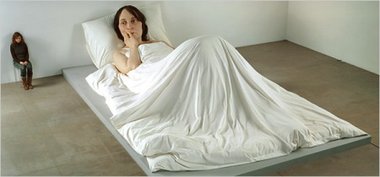

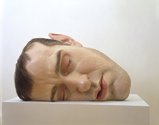
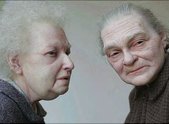
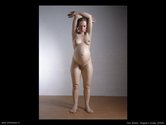
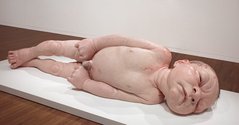
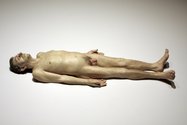
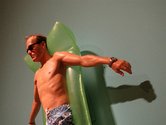
 Advertising in this column
Advertising in this column Two Rooms presents a program of residencies and projects
Two Rooms presents a program of residencies and projects



This Discussion has 0 comments.
Comment
Participate
Register to Participate.
Sign in
Sign in to an existing account.